Spam goes glam
By Debra Samuels, Globe Correspondent
WELLESLEY — Those who know Susumu “Sus” Ito, 93, know that he is a Nisei (second-generation Japanese-American), a Congressional Gold Medal recipient from World War II’s legendary all-Japanese-American 442d Regimental Combat Team, an emeritus professor at Harvard Medical School, a furniture maker, photographer, dad, and grandfather.
(Sus is second from right)
But what many may not know is that Ito is also a master at Spam musubi, the Hawaiian snack made with the infamous canned ham and rice. Spam musubi is part of a cuisine adapted by Japanese immigrants who settled in Hawaii in the first half of the last century. One of their specialties was rice balls (musubi). GIs stationed in Hawaii had in their rations cans of Spam, the meat product made by Hormel Foods with pork shoulder, ham, and spices, says Ito.
Over time, Japanese cooks found Spam (the words combine “spiced” and “ham”), added it to their rice, and Spam musubi was born. The dish is made by pan frying slices of Spam and setting them between layers of rice, then seasoning and wrapping them in nori, a roasted seaweed.
Today, like other transmogrified dishes, Spam musubi has enthusiasts far from its birthplace; it’s popular in California and even spotted at izakaya, Tokyo pubs. Think of it as something like California rolls. The sushi rice with avocado and crab, an American twist on Japanese cuisine, made its way back across the Pacific.
Ito was raised in Stockton, Calif., and learned to cook from his mother, Hisayo, who made traditional maki zushi, rice rolls with vegetables. In 1941, while he served in the US Army, his mother and family were interned at Topaz in Utah and he would visit periodically.
Ten 10 years ago, after a trip to California, when he tried Spam musubi, he thought, “I can make this myself.”
He lives in the Wellesley home he shared with his late wife of 64 years, Minnie Tsuji Ito, cooking and cleaning for himself, even chopping logs for a wood-burning stove. On a bright day in his kitchen, the spry nonagenarian lines up the ingredients for musubi. He opens a can of Spam, slices and browns it in a skillet with teriyaki sauce, and lets it form a shiny glaze. “I ate a lot of Spam while I was in the Army,” says Ito, “and didn’t really like the taste then.”
Now the dish is his specialty. To make the layers, he uses a two-piece plexiglass press about 2-inches-by-2-inches-by-4-inches to shape it, scooping the rice and spreading it inside one piece of plexiglass. With chopsticks he picks up a piece of Spam and lays it on the rice,
adds a drizzle of wasabi sauce, a flourish of red ginger shreds, and a shower of Japanese savory sprinkles (called furikake; this is his secret seasoning), a combination of seaweed, sesame seeds, and dried salmon flakes.
Then he spreads on one more layer of rice, dips the smaller flat plexi rectangle, which is fitted with a grip, into water, and presses down on the layers.
He lifts the form and wraps the rice and spam in roasted seaweed. With the tip of a knife moistened with water, he slices his masterpiece into several pieces. Then he makes another and another. “No way mom would make this,” he says, amused.
The sweet, salty, very rich meat, rice, and seasonings blend together in an unlikely but delicious combination.
Ito’s Spam musubi is in demand. Whenever he attends a meeting or party, he brings along a tray. Every year Margie Yamamoto, a Lincoln resident and friend of Ito’s, hosts a Japanese New Year’s party for over 100, and Ito’s Spam musubi is a hit.
Yamamoto reports that her guests ask, “What’s this? It’s fabulous!”
Then she tells them it’s Spam.
RECIPES
Spam Musubi
Makes 20 pieces or enough to serve 6
There are many ways to stack this snack. One is a grilled or fried Spam slice on a ball of rice, wrapped with roasted seaweed. Another is a sandwich-like layering of rice and Spam, also wrapped with seaweed. This version, from Susumu Ito, uses short-grain Japanese rice, sometimes labeled “sushi rice,” and a kind of teriyaki called Mr. Yoshida’s Original Gourmet Sweet and Savory cooking sauce. He has a plexiglass mold designed specifically for spam musubi (about $7 at Houserice.com), or use the Spam can as the form. Remove the Spam, with a can opener, carefully snip out and discard the bottom. Smooth any jagged edges with the tip of a knife. Wash in warm soapy water (mind your fingers), and dry with paper towels. To fill, place the can bottom side down.
RICE
| 1¾ | cups short-grain Japanese rice |
| 1¾ | cups plus 2 tablespoons water |
1. In a mesh sieve set in a bowl in the sink, set the rice. With the water running, gently swish your hand in the rice; the water will turn milky. Lift the sieve and shake off the water. Repeat 3 times. Drain and set aside for 20 minutes.
2. In a heavy-bottomed saucepan, combine the rice and the water with the cover askew. Cook the rice over medium high heat for 10 minutes. Turn the heat to low and continue cooking for 10 minutes more. Remove the rice from the heat, cover, and set aside for 10 minutes.
3. Fluff the rice with a wooden spoon. (Use it warm.)
FILLING
| Half of a 12-ounce can Spam or Spam Lite | |
| ¼ | cup bottled teriyaki sauce |
| ½ | teaspoon wasabi powder mixed to a paste with 1 teaspoon water |
| ⅓ | cup mayonnaise |
| 3 | sheets nori (roasted seaweed) |
| ¼ | cup red pickled ginger (kizami shoga), drained (available at Asian markets) |
| 2 | tablespoons Japanese Rice Seasoning (furikake) (available at Asian markets) |
1. Pull off the Spam lid and gently slip a knife around the edges and sides to loosen it from the can. Over a plate, shake the can so the block comes out in one piece. With a thin knife, slice the Spam lengthwise into 5 pieces, each ¼ inch. (You will use half the block. Place the remaining Spam in an airtight container and refrigerate to use in other dishes, like fried rice.)
2. In a skillet over medium heat, brown the Spam for 1 minute on each side. Add the teriyaki sauce and cook, turning occasionally, for 2 minutes or until the sauce almost evaporates. Transfer to a plate.
3. Have on hand a bowl of cold water and a ⅓-cup measure.
4. In another small bowl mix the wasabi paste and mayonnaise.
5. Fold the nori sheets in half horizontally and with scissors cut in half along the fold.
6. Set a half sheet of nori, shiny-side down, horizontally in front of you. Place the musubi mold or Spam can in the middle of the nori in a vertical position. Dip the measure into the water and shake off the excess. Scoop ⅓ cup of rice and make a bed in the bottom of the mold. Dip a spoon into the water and tamp down the rice. Add a slice of Spam, a little wasabi mayonnaise, about 1 teaspoon of pickled ginger, and 1 teaspoon of rice seasoning.
7. Dip the measure into water, shake off, and scoop another ⅓ cup of rice. Spread over the seasonings. With the back of a wet spoon, firmly tamp down the rice. If using a musubi press, dip the flat lid into the water, shake off, and tamp down on the rice.
8. Carefully lift the mold or can off the rice. With a wet finger dab the right edge of the nori. Bring the left side up and over the rice. Bring the right side up to overlap the left side. Lightly press down on the seam. Set the finished musubi on a tray, lightly covered with plastic wrap. Repeat with the remaining nori, rice, Spam, and seasonings.
9. To cut the musubi, wet a paper towel and moisten the edge of a knife (not serrated). Cut the block in half. Wet the knife again and cut each piece in half to make 4 pieces. Continue with the other blocks. Arrange the slices on a platter. Serve with cucumber pickles. Adapted from Susumu Ito
Fried rice with Spam and pineapple
Serves 4
One of the most popular ways to use Spam is in a Chinese-style fried rice with pineapple. Leftover short- or long-grain rice that has been refrigerated overnight works well; this removes some of the moisture and makes it crispier after frying.
4 teaspoons vegetable oil
1 onion, chopped
Half of a 12-ounce can Spam or Spam Lite, cut into 1-inch chunks
1 cup frozen peas and carrots
2 cups cooked white rice
Salt and pepper, to taste
2 tablespoons hoisin sauce
1 can (8 ounces) pineapple chunks, drained and roughly chopped
2 eggs
2 teaspoons dark sesame oil
1 scallion, finely chopped
1. In a large skillet over medium heat, heat 3 teaspoons of the oil. Add the onion and cook, stirring, for 5 minutes. Add the Spam and cook, stirring often, for 3 minutes, or until the Spam is lightly browned. Stir in the peas and carrots and cook for 1 minute more.
2. Add the rice, salt, and pepper. Stir well until completely combined. Cook, stirring often, for 3 minutes, or until the rice begins to brown. Stir in the hoisin sauce and pineapple. Cook, stirring, for 1 minute more.
3. In a bowl, whisk the eggs and sesame oil. With a wooden spoon, push the rice to the side of the skillet farthest from you. Sprinkle the remaining 1 teaspoon oil in the empty part of the skillet. Heat it for 30 seconds. Pour the eggs into the skillet and cook, stirring constantly, until they start to scramble. Fold them into the rice as they begin to set.
4. Taste for seasoning and add more salt and pepper, if you like. Sprinkle with scallions.Debra Samuels

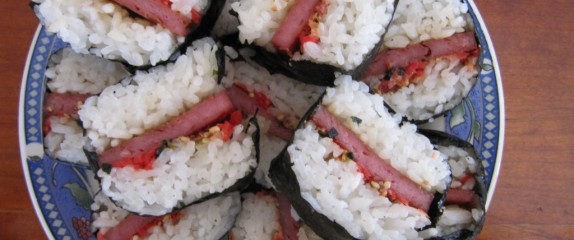


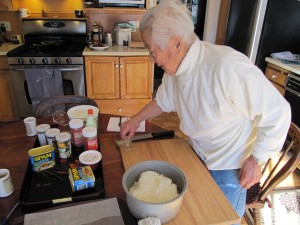
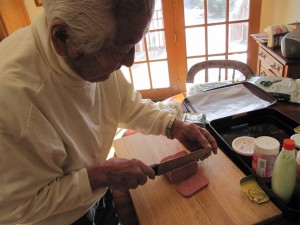
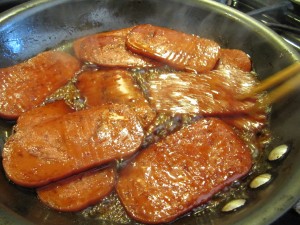
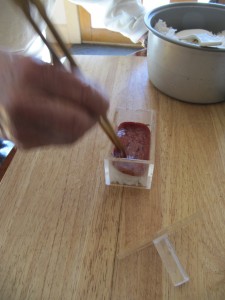
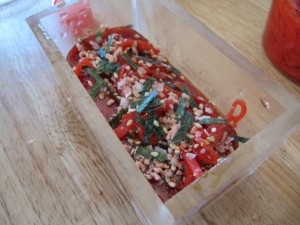
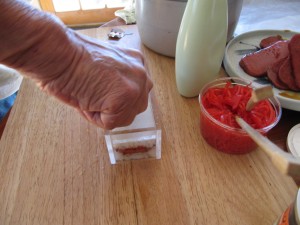
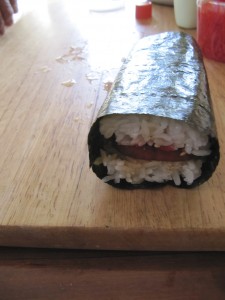
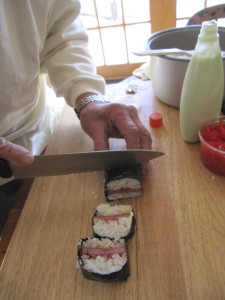
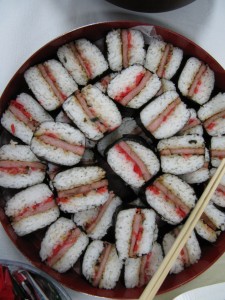
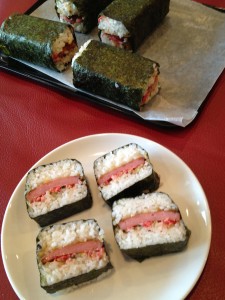
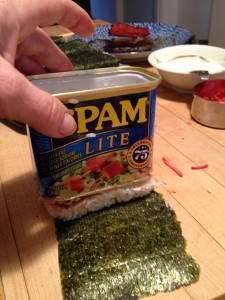











 Debra Samuels, bestselling author, food writer and cooking instructor,
Debra Samuels, bestselling author, food writer and cooking instructor,